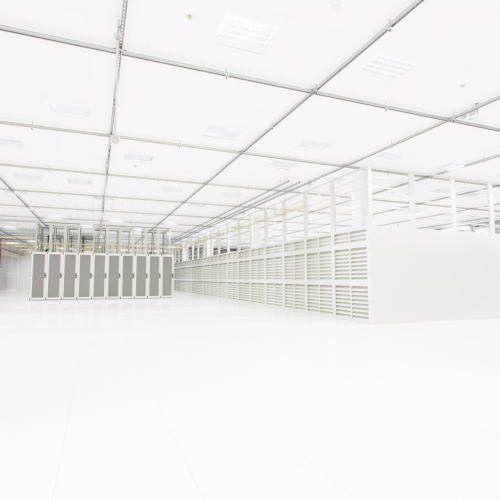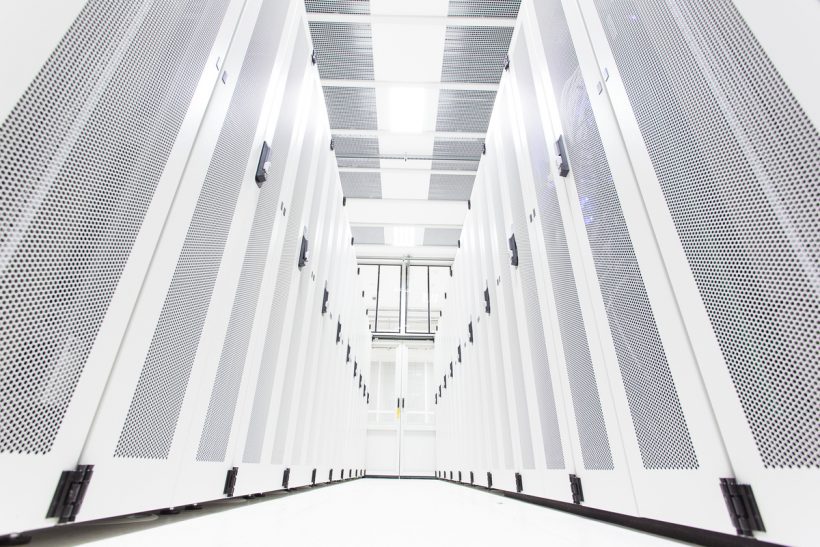Anticipating the failure of digital devices has become part of the fabric of everyday life in the digital world. With their fragile components and ever-shortening lifespans, digital technologies increasingly require their users to take preparatory action if they want to avoid losing their digital photos, files and other precious data when device failure should arise. Programs like Apple’s Time Machine or Windows’ Backup and Restore make it easy for users to back-up their computers onto external hard drives. These programs regularly prompt users with push notifications if a back-up is overdue, reminding them that device failure and data loss can occur at any moment, for which they must be prepared.
The cloud is an infrastructure that is made through and for technological failure.
Increasingly, more and more users are now turning to various cloud storage solutions to back-up their files online. Dropbox, Google Drive, Apple’s iCloud and Microsoft’s OneDrive promise users quick, easy, secure and supposedly infinite data storage, for a monthly subscription fee. Backing-up into the cloud has the advantage of providing users with a centralised online data storage space from which they can access and synchronise their files across their devices. No matter what should happen to a device, cloud providers promise users that their digital data will remain safe, accessible and ready to be quickly re-installed on another system as and when failure arises.
Beyond Device Failure
Obsolete or broken devices have surfaced as valuable entry-points for exploring the unethical and unsustainable operating logics of a technology industry that capitalises on the failure of digital commodities (Parks 2007; LeBel 2012; Gabrys 2013). A focus on cloud storage provides an opening onto another side of this economy of techno-failure, directing analytical attention towards the profit that can be extracted from user anticipations of device failure. Such a focus expands the temporal horizons of discard studies, which often addresses the afterlives of digital devices.
For the past several years, I have conducted field research in the ‘cloud’, spending time with data centre providers and IT disaster recovery vendors. I’ve been exploring how, since the mid-twentieth century, the prospect of digital data loss has energised an ever-expanding industry of data recovery, back-up and salvage services. In the process, I’ve followed the extensive infrastructure, energy and human labour involved in keeping cloud services up and running.
A focus on cloud storage provides an opening onto another side of this economy of techno-failure, directing analytical attention towards the profit that can be extracted from user anticipations of device failure.
As I have highlighted elsewhere, while a flourishing body of literature is now exploring the new forms of data-based and virtualised labour enabled by cloud platforms, the labour of those tasked with maintaining and servicing the infrastructure that underpins cloud capitalism itself has been critically overlooked. Shadowing the work of cloud professionals, including security guards, disaster recovery managers, IT technicians and data centre operators, my research intersects with a growing body of scholarship that focuses on maintenance, repair and failure (Star 1999; Graham and Thrift 2007; Harvey et al. 2013; Carroll 2017; Russell and Vinsel 2018; Mattern 2018).
Failover
The cloud is an infrastructure that is made through and for technological failure. At its most basic, cloud computing describes a form of ‘online’ data storage. Rather than storing data locally on the hard drives of personal computers, the cloud enables users to store files on servers in data centres that are accessed remotely ‘as a service’ through the internet. Providing a data storage site safely removed from the local storage of the device, cloud providers strive to ensure that device failure doesn’t result in data loss.
This promise is primarily achieved through the construction of multiple, often globally-distributed data centres. If for any reason the primary data centre should experience an outage due to local-level disaster, it will automatically switch (or, in data centre parlance, ‘failover’) to the back-up data centre(s), which is ideally located outside the disaster region. Guided by logics of preparedness, the end result of this extensive failover infrastructure is ‘a massively-distributed geography of back-up and repair spread across the world’ (Graham 2013: 30).
The ultimate goal is to produce a ‘world without events’ for cloud clients – that is, a world in which device malfunction, obsolescence, thefts, or upgrades barely register as disruptions.
By choreographing and connecting an expanding network of data centres, cloud providers aim to ensure that, when clients’ devices or IT systems fail, their data can be instantly retrieved and re-downloaded without delay, minimising any disruption that failure would otherwise generate. The ultimate goal is to produce a ‘world without events’ (Masco 2014: 31) for cloud clients – that is, a world in which device malfunction, obsolescence, thefts, or upgrades barely register as disruptions. By rendering client data continuously available across devices that continuously fail, cloud providers strive to smooth out and absorb the disruptive impact of device failure. This has implications for how we think about and theorise failure in relation to digital technologies.
The Failure of Failure?
It has long been a commonplace in analyses of human-machine relations that the failure of technological objects, systems or tools is a disruptive event. Stemming from Heidegger’s philosophy of technology, it has been widely theorised that, in their moments of malfunction, technologies shift status from being almost-invisible tools that facilitated work into stubborn and unruly objects that disrupt routines or habits (Verbeek 2004: 79). If technology is designed to disappear, then, upon breakdown, it forcefully reappears. This moment of reappearance via breakdown has been of great interest to social theorists because it provides an opening onto complex and fragile relations between people, technologies and the industries that design and provision them – relations that are concealed or go unnoticed when the object is working smoothly. From this perspective, failure, malfunction and breakdown present valuable analytical opportunities precisely because they are understood as exceptional, disruptive and revelatory instances rather than normal operating states, through which we can therefore learn something new about our world.
If technology is designed to disappear, then, upon breakdown, it forcefully reappears.
But what happens when failure becomes the norm? What happens when failure ‘fails’ to disrupt, to produce knowledge or to register as an ‘event’? Arjun Appadurai and Neta Alexander (2020: 120) have recently suggested that digital tools and pre-digital tools carry different epistemic potential when they fail. ‘[I]s not the failure of the smartphone simply the failure of the iron hammer as the wooden handle breaks?’, they ask. They answer this question in the negative, arguing that the regularity with which digital technologies freeze, crash and break narrows the epistemic horizons of their failure. ‘[O]ur technological failures’, they suggest (ibid.), ‘do not teach us something new about our world; their repeated breakdowns do nothing more than further obstruct the underlying logic and hidden infrastructures that sustain them’. With digital devices, they posit, the relation between failure and knowledge production begins to break down.
If, for Appadurai and Alexander, it is the regularity of device breakdown that renders failure ordinary rather than revelatory, the cloud further obfuscates and limits the subversive capacity of failure by rendering device loss or malfunction as non-disruptive as possible. With the cloud’s promise to ensure users’ files are safe and ready and waiting to be swiftly accessed, downloaded and re-installed on their next device, this infrastructure works to absorb the disruptive or traumatic impact of data loss that might otherwise accompany device malfunction. As such, the cloud is a key mechanism through which the ordinary crises of device failure (Chun 2016) are transformed from shocking or rupturing events into permissible and (relatively) non-disruptive and non-revelatory events.
At the same time, the ‘world-disclosing properties of breakdown’ (Jackson 2014: 230), have not entirely been sealed off by the cloud. While the cloud may strive to render device failure as painless, uneventful and forgettable as possible, it also produces new opportunities for disruption. Users can get locked out of their files if their accounts are hacked or if they don’t have internet connectivity. Data could be lost as a result of unanticipated server downtime. The proliferating excess of cloud infrastructure also increases the potential for cascading, global-scale failures, as testified by data centre failures involving organisations like British Airways.
Maintaining Failure
Underpinning the growing adoption of cloud-based back-up solutions is an awareness and anticipation of the anytime-anywhere potential of digital devices to crash or break, potentially taking the files, photos and other data they contain with them (Schüll 2018). While devices are largely replaceable, the data stored on them is not.
Smartphones, tablets and laptops may come to simply serve as tools with which technology companies can lock users into their cloud service, converting time-limited device-customers into lifelong cloud-customers.
Purporting to separate data from the fragile materiality of digital devices (by duplicating it on equally fragile servers in data centres), cloud providers thus promise their clients a form of transcendental and perpetual data storage that will last into the future. Different scales of digital time are at work here. While laptops, tablets, smartphones and other digital commodities are defined by their rapid and engineered obsolescence, the cloud offers a longer-term temporality that transcends the lifespan of the device. For technology behemoths like Microsoft, Apple and Google, cloud storage is a key strategic tool in the long game for revenue growth. As users generate increasingly large volumes of born-digital data through their devices, their cloud storage needs for these ever-accumulating personal digital archives will continue to grow over their lifetimes, as will the cost of their cloud subscription fees. While a few gigabytes of introductory cloud storage space are often provided for free, the monthly subscription costs for additional storage can quickly become expensive. At the time of writing this article there is no bank-like ‘switching service’ that enables users to quickly and easily move their data between cloud providers who may offer better rates. Given the difficulty involved in transferring large amounts of data from one cloud storage space to another, smartphones, tablets and laptops may come to simply serve (if they are not already) as tools with which technology companies can lock users into their cloud service, converting time-limited device-customers into lifelong cloud-customers.
By making it quick and easy for users to simply re-download their data to a new device, rather than change the sociotechnical and economic conditions that culminate in recurrent device failure in the first place, the cloud props up and supports the continuity of a techno-economic system based on continuous device failure and perpetual upgrading. This is not simply the work ‘of maintaining media artifacts, systems, and technologies’ (Jackson 2014: 231) but the work of maintaining the failure of these technologies; the work of rendering their failure permissible by ensuring that their most valuable element – the data they contain – is not lost with them. It is the work of extracting further value from futures of failure beyond profits derived from design logics of engineered obsolescence or marketing strategies based on encouraging conspicuous technological consumption. When failure becomes regular and intentional (‘engineered’, ‘designed’ or ‘planned’) it requires labour and infrastructure to render it tolerable. The cloud and the device must thus be seen as two parts of a recursive and self-perpetuating techno-economic cycle of data preparedness and technological failure. The failure of technology becomes something to be managed rather than avoided, a techno-precarity (Precarity Lab 2020) that we must learn to live with if we don’t want to lose our data.
References
Appadurai, A. and Alexander, N. (2020) Failure. Cambridge: Polity Press.
Carroll, T., Jeevendrampillai, D., Parkhurst, A. and Shackelford, J. (eds.) (2017) The Material Culture of Failure: When Things Do Wrong. London and New York: Bloomsbury.
Chun, W.H.K. (2016) Updating to Remain the Same: Habitual New Media. Cambridge, Massachusetts: MIT Press.
Gabrys, J. (2013) Digital Rubbish: A Natural History of Electronics. Ann Arbor: University of Michigan Press.
Graham, S. and Thrift, N. (2007) ‘Out of Order: Understanding Repair and Maintenance’. Theory, Culture and Society, 24(3): 1-25.
Graham, S. (2013) ‘Stealth Architectures and the Geographies of Back-up.’ In A. Fard and T. Meshkani (eds.) New Geographies 7. Harvard University, Graduate School of Design, pp. 29-36.
Harvey, P., Reeves, M. and Ruppert, E. (2013) ‘Anticipating Failure: Transparency Devices and their Effects’. Journal of Cultural Economy, 6(3): 294-312.
Jackson, S.J. (2014) ‘Rethinking Repair’. In T. Gillespie, P.J. Boczkowski and K.A. Foot (eds.) Media Technologies: Essays on Communication, Materiality, and Society. Cambridge, Massachusetts and London: MIT Press, pp. 221-239.
LeBel, S. (2012) ‘Wasting the Future: The Technological Sublime, Communications Technologies, and E-waste’. communication +1, 1(1): 1-19.
Masco, J. (2014) The Theatre of Operations: National Security Affect from the Cold War to the War on Terror. Durham, North Carolina: Duke University Press.
Mattern, S. (2018) ‘Maintenance and Care’. Places Journal. https://doi.org/10.22269/181120
Parks, L. (2007) ‘Falling Apart: Electronics Salvaging and the Global Media Economy’. In C. Acland (ed.) Residual Media. Minneapolis: University of Minnesota Press, pp. 32-47.
Precarity Lab (2020) Technoprecarious. Cambridge, Massachusetts: MIT Press.
Russell, A.L. and Vinsel, L. (2018) ‘After Innovation, Turn to Maintenance’. Technology and Culture, 59(1): 1-25.
Schüll, N.D. (2018) ‘Digital Containment and its Discontents’. History and Anthropology, 29(1): 42-48.
Star, S.L. (1999) ‘The Ethnography of Infrastructure’. American Behavioral Scientist, 43(3): 377-391.
Verbeek, P. (2004) What Things Do: Philosophical Reflections on Technology, Agency and Design. University Park: Pennsylvania State University Press.












Such a great essay and insight. Thanks for this! And for the reference to discard studies’ page. Containers are fun to think with